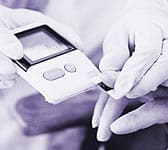Life Extension Magazine®
DHEA Improves Insulin Response | ||
Dehydroepiandrosterone (DHEA) administered to women with adrenal insufficiency improves insulin sensitivity, according to Mayo Clinic investigators.1 DHEA, a steroid released from the adrenal gland, has been shown benefit some medical conditions coincident with aging, such as heart disease and diabetes. Adrenal insufficiency and diminished DHEA levels become more prevalent with advancing age. In the Mayo Clinic study, 28 women with adrenal insufficiency received 50 mg of micronized DHEA or placebo daily for 12 weeks, underwent a two-week washout period, and then received the alternative preparation for 12 weeks. After each of the two 12-week study periods, the participants underwent metabolic testing. In as little as 12 weeks, replacement doses of DHEA produced a clinically significant decline in fasting insulin levels. Fasting plasma glucose levels were likewise lower with DHEA supplementation than with placebo. Improved “efficiency” of insulin during DHEA replacement was demonstrated by the greater amount of dextrose infusion required to maintain equivalent blood glucose levels in the two groups of patients.1 This study strongly suggests that DHEA replacement increases insulin sensitivity and improves glucose metabolism, and that DHEA may play an important role in preventing type II diabetes.1 These findings also support a recent study in which DHEA supplementation helped improve insulin sensitivity in otherwise healthy elderly men and women.2 DHEA may exert its effects by helping to decrease the abdominal fat that often increases with age and is associated with lowered —Linda M. Smith, RN | ||
| References | ||
| 1. Dhatariya K, Bigelow ML, Nair KS. Effect of dehydroepiandrosterone replacement on insulin sensitivity and lipids in hypoadrenal women. Diabetes. 2005 Mar;54(3):765-9. | ||
Blood Vessel Drugs Once Called Failures Halt Cancer Growth | ||
| Nobody believed Judah Folkman when, in the 1960s, he claimed that the growth of cancers could be stopped, even reversed, by blocking the tiny vessels that feed them blood. Over the years, however, he has survived peer rejection of his theory, and gone on to develop drugs that did what he predicted they would do. In 1998, Endostatin™, one of several anti-blood-vessel-growth drugs developed in his lab, was hyped by the media as a “cure” for many different cancers. A scant seven years later, Fortune magazine derided it as a “failure.” Both statements turn out to be high exaggerations. A professor of pediatric surgery and cell biology at Harvard Medical School and Children’s Hospital in Boston, Folkman today is excited by what he sees in the scientific, if not the public, press. Endostatin™, the drug Fortune called a failure, was used to treat 486 patients with lung cancer in China. At Dana-Farber Cancer Institute in Boston, it has given new lives to four adults who have been taking it, and it is helping children with brain and other tumors.
A related drug, called Avastin™, was approved for use in the United States in February 2004. Since then, 27 other countries have OK’d it for treating colon cancer. Avastin™ is also being tested on patients with kidney, breast, and ovarian cancers. In addition, another blood-vessel-growth blocker, Tarceva®, has been approved for treatment of lung cancer in the United States. Researchers have also associated overgrowth of blood vessels with macular degeneration, the leading cause of blindness in elderly people. Convinced that blood-vessel-growth blockers can help these people, the Food and Drug Administration approved a drug called Macugen™ for this purpose in December 2004. Avastin™, which is made by Genentech Inc., also shows promise for treating macular degeneration. A common antibiotic, doxycycline, was found to possess anti-blood-vessel-growth properties. So was the popular painkiller Celebrex®. Thirty to 40 other blood-vessel-growth inhibitors are now undergoing tests in patients with different types of cancers. And additional varieties of the drugs are under development to treat other diseases. Every week, Folkman sees encouraging scientific reports on the drugs he has grandfathered, but he’s not the type to gloat or scream for vindication. “It’s a large, fast-moving field,” he says modestly. “And I’m excited to see the high rate of progress.” Ups, Downs, and Ups AgainFolkman showed signs that he would revolutionize medicine in high school when, in the basement of his family’s Ohio home, he made a crude pump to keep a rat’s heart pumping blood. During medical training in the 1950s, Folkman and another student built an implantable pacemaker to shock weakened hearts back into a normal rhythm. But it was in 1961 when he made the discovery that now dominates his life. Folkman and a colleague noticed that malignant mouse tumors implanted into isolated organs never grow beyond the size of a pinhead. But replant those tumors into the bodies of live animals, and they expand rapidly. From this, Folkman came up with the then-radical idea that tumors secrete proteins able to stimulate the growth of hair-thin blood vessels that bring them nutrients and carry away their wastes. He applied the name “angiogenesis,” meaning “birth of blood vessels,” to this process. In 2005, no scientist or physician doubts the existence of angiogenesis or its major role in cancer, but in the early 1970s Folkman’s idea was heavily criticized. “Fantasy,” some experts labeled it. By 1997, Folkman and his colleagues at Boston’s Children’s Hospital found a natural compound they called Endostatin™, which blocks the growth of blood vessels and shrinks tumors without the usual harsh side effects of chemotherapy. The battle over Endostatin™’s efficacy as a drug, however, still rages. In 1998, the stock of the company that made the drug, EntreMed, rocketed 381%. But the company went broke and had to stop making Endostatin™. A major problem still exists, Folkman notes, over the way doctors measure the success or failure of anti-cancer drugs. If a tumor shrinks at least 50%, they call it a “partial response” to the medication. Anything less becomes a “no response.” Endostatin™ has stabilized cancer growth, or produced slow tumor regression, over a period of three years in some patients. Although that’s less than a 50% response, some of the patients have gone back to work and to playing golf. Four who have been on the drug for at least 3 1/2 years are enjoying normal lives. “They were very disappointed with media reports calling Endostatin™ a failure,” Folkman points out. Doctors at Harvard-affiliated Children’s Hospital and Dana-Farber Cancer Institute can’t get as much of the drug as they want. Mark Kieran of Children’s Hospital is now testing Endostatin™ against all types of solid tumors in children, including those of the brain, bone, and muscle.
The Boom Is OnAvastin™ (whose generic name is bevacizumab) enjoys good press and proves that Folkman has been on the right track for the past 33 years. “Avastin™ vindicates the idea that tumors can be effectively controlled by targeting the network of blood vessels that feed them,” says Joseph Paul Eder, a Harvard associate professor of medicine who treats patients at Dana-Farber Cancer Institute. The drug has won approval from governments all over the world for its success in treating colon cancer. Once that door opened, researchers began trying it on other malignancies. Leonard Appleman is testing Avastin™ on kidney cancer patients at Dana-Farber. Harold Burstein, working at the same institute, has almost finished his tests of it on women with breast cancer, and says he will report his results in December. Others are treating ovarian cancer with Avastin™. No results have been formally announced, but word from people close to these trials indicates that Avastin™, used by itself and in combination with other drugs, shows that the angiogenesis-blocker boom is on. One scientist, who did not want to be identified but who has been involved for years with testing the drugs, says: “If I had cancer, I’d want Endostatin™ or Avastin™, or both.” Reprinted with permission of William J. Cromie, Harvard University Gazette. |





